
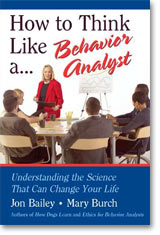
How to Think Like a Behavior Analyst
is a revolutionary resource for understanding complex human behavior
and making potentially significant quality of life improvements. Behavior
analysts offer a worldview of the human condition different than almost
any other professional perspective. To a behavior analyst, human behavior
is largely learned and subject to change if the right variables are put
into play. This is an empowering outlook, providing an opportunity for
individuals to analyze the actions of those around them and an understanding
of why others exhibit such behavior.
Practical, clear, and direct, this book addresses basic questions such
as how behavior analysis is different from psychotherapy, what analysis
involves, and the meaning of evidence-based treatment. A chapter on Applications
presents tips on using behavioral procedures to improve lives and deal with
others, and articulates how behavioral procedures are used in community
settings. In question and answer format, the text thoroughly covers 50 frequently
asked questions about behavior analysis in an educational and entertaining
manner. It was developed out of questions raised by students in behavior
analysis classes over the last 35 years, as well as questions raised by
consumers of behavior analysis services.
This text is written for all professionals concerned with behavior, including
undergraduate students in psychology and behavior analysis, parents, teachers,
employers, and employees. The book can easily be used as a supplement to
primary texts in introductory psychology courses, and the exercises that
follow each question can be used to stimulate lively discussion in role-play
and other active learning situations.
“Jon Bailey and Mary Burch have written a book the discipline
of Applied Behavior Analysis drastically needs. It presents Applied Behavior
Analysis so the public can reap the many benefits of this approach to
improving human competence. More imp;ortantly, this text could serve as
a supplementary reading in numerous psychology courses from Introductory
Psychology to courses in Learning , OBM, Clinical Psychology, and even
I/O Psychology."
--E. Scott Geller, Virginia Tech
"What a wonderful trip through the eyes of a behavior analyst!
How to Think Like a Behavior Analyst provides guides to working on everything
from the most challenging behaviors of a learner with autism to the much-needed
training of your boyfriend to do your laundry. Reading ths manual is
the best way to get a parent to understand what Applied Behavior Analysis
is in very simple terms, something that has been long overdue int eh field
of Autism! As founder of an organization to train parents and educators
about Autism and Applied Behavior Analysis this will be the first reading
assignment for our newcomers. It's brilliant and well written."
--Debora Harris, BCABA, co-Founder fo the Elija Foundation
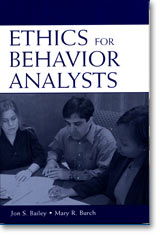
Ethics for Behavior Analysts
Behavior analysis, a rapidly growing profession, began with the use and
application of conditioning and learning techniques to modify the behavior
of children or adults presenting severe management problems, often
because of developmental disabilities. Now behavior analysts work in
a variety of settings, from clinics and schools to workplaces. Especially
since their practice often involves aversive stimuli or punishment,
they confront many special ethical challenges. Recently, the Behavior
Analysis Certification Board codified a set of ten fundamental ethical
guidelines to be followed by all behavior analysts and understood by
all students and trainees seeking certification.
This book shows readers how to follow the BACB guidelines in action. The authors first describe core ethical principles and then explain each guideline in detail, in easily comprehensible, everyday language. Ethics for Behavior Analysts is richly illuminated by more than a hundred vivid case scenarios about which the authors pose, and later answer questions for readers. Useful appendices include the BACB Guidelines, an index to them, practice scenarios, and suggested further reading.
Practitioners, instructors, supervisors, students, and trainees alike will welcome this invaluable new aid to professional development.
“The field of Applied Behavior Analysis (ABA) has experienced
explosive growth over the last decade and a half. The over-riding goal
of any ABA effort must be to increase the autonomy of the individual,
his/her ability to make choices for his or her own life and to live independently
within society. Unfortunately, many individuals who are supposedly providing
ABA services have not received the training needed to engage in this effort
responsibly, effectively, and ethically. Such individuals cannot therefore
carry out the mission of ABA stated above. This book addresses the all-important
ethical responsibilities of a behavior analyst, discussing the responsibilities
of behavior analysts as regards their clients, colleagues, and the greater
field. It should be required reading for anyone who wants to be involved
in ABA. Perhaps most importantly for consumers, a familiarity with this
book will allow a determination of the qualifications and ethical stances
of prospective behavior analysts.”
--Bobby Newman
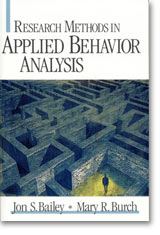
Research Methods in Applied
Behavior Analysis
This very practical, how-to text provides the beginning researcher with
the basics of applied behavior analysis research methods. In 10 logical
steps, this text covers all of the elements of single-subject research
design and it provides practical information for designing, implementing,
and evaluating studies. Using a pocketbook format, the authors provide
novice researcher with a "steps-for-success" approach that
is brief, to-the-point, and clearly delineated.
Research Methods in Applied Behavior Analysis teaches the reader how to choose a research topic, how to identify a good setting for research, and how to access research settings. This text also teaches the reader to design a data collection system, conduct a pilot test, identify the appropriate research design, and to conduct an ethics check. The authors have included daily and weekly checklists for success and information is provided on the visual analysis of data. The final section of Research Methods (Part III. Going Public) addresses the practical skills needed to present research at a conference or to submit findings for publication.
There is no other practical, how-to handbook on Research Methods that so clearly outlines the steps for conducting behavioral research.
"There is a definite need for a ‘how to’ book such as
this to train behavior analysts…The authors have a very thorough
and understandable approach to the topics. They include lots of examples
and everyday insights and practical tips that are valuable to new researchers…The
strength of this book seems to be in the authors’ experience and sharing
of practical advice to readers."
--Don Patterson

How Dogs Learn
How Dogs Learn explores the fascinating science of operant conditioning,
where science and dog training meet. How Dogs
Learn explains the basic
principles of behavior and how they can be used to teach your dog new
skills, diagnose problems and eliminate unwanted behaviors. It's for
anyone who wants to better understand the learning process in dogs.
Every concept is laid out clearly and precisely, and its relevance
to your dog and how you train is explained.
The authors, recognized experts in this field, are also experienced dog trainers, and they explain each operant conditioning principle using dog training examples. For the first time, behavioral procedures that are used with humans, such as Behavioral Diagnostics and Functional Analysis, have been translated for applications with dogs. How Dogs Learn will help all dog owners solve canine behavior problems and improve their proficiency as trainers.
"...this book should be on every animal trainer's bookshelf for future
reference. How Dogs Learn covers the content of an undergraduate course
in learning and behavior, but the examples are taken from dog training…it
is practical and very useful without sacrificing scientific and technical
accuracy."
--Jack Michael, PhD, Department of Psychology, Western Michigan
University
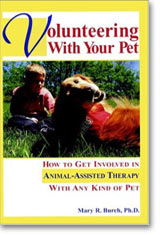
Volunteering with Your Pet
Whether it's a bird, a cat, a horse, barnyard animal or traditional dog...whether
it's a kindergarten class, a prisoner, a paraplegic or an AIDS patient,
there are ways in which all sorts of pets can help people. This book
discusses all the elements of animal-assisted therapy so that readers
can learn what it takes to get involved and make a difference. Learn
about therapy organizations, requirements for your pet and what to
expect from this work.
"Dr. Mary Burch’s 'Volunteering with Your Pet' is
a necessary manual for anyone who wishes to join the growing number
of volunteers… supplementing
conventional medicine with the healing potential of contact with animals."
--Dr. Aaron Katcher, Associate Professor Emeritus, Oral Medicine and
Psychiatry, University of Pennsylvania
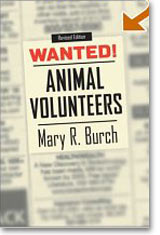
WANTED: Animal Volunteers
Now Completely Revised, the Definitive Guide for Animal Lovers Who Want
to Get Involved in Animal-Assisted Therapy . . . For nursing home residents,
AIDS patients, people with emotional or physical handicaps, and even
prisoners, contact with animals can help lower blood pressure, release
endorphins, and achieve specific treatment or program goals. This information-packed
guide explains how you and your pet can make a difference in the lives
of others.
Drawing from personal experience, extensive research, and heartwarming case studies, Mary Burch provides practical information for those wanting to volunteer with animals–from obtaining liability insurance to evaluating clients progress. Not just an arena for dogs or cats, animal-assisted activities can involve rabbits, guinea pigs, horses, farm animals, and just about any other kind of animal. With Wanted! Animal Volunteers youll discover what a difference you can make simply with your time, creativity, and love for animals.

The Border Collie; An Owner’s Guide To A Happy
Healthy Pet
At last, a book about Border Collies that emphasizes total care, training
and companionship! You'll not only learn about the species-specific
traits of this remarkable breed, you'll also learn what the world's
like from your Border Collie’s perspective; how to feed, groom
and keep your dog healthy; and how to enjoy your Border Collie through
training and activities you can do together. The
Border Collie includes
a special chapter on training by Dr. Ian Dunbar, internationally renowned
animal behaviorist. Best of all, the book is filled with info-packed
sidebars and fun facts to make caring for your Border Collie easy and
enjoyable.